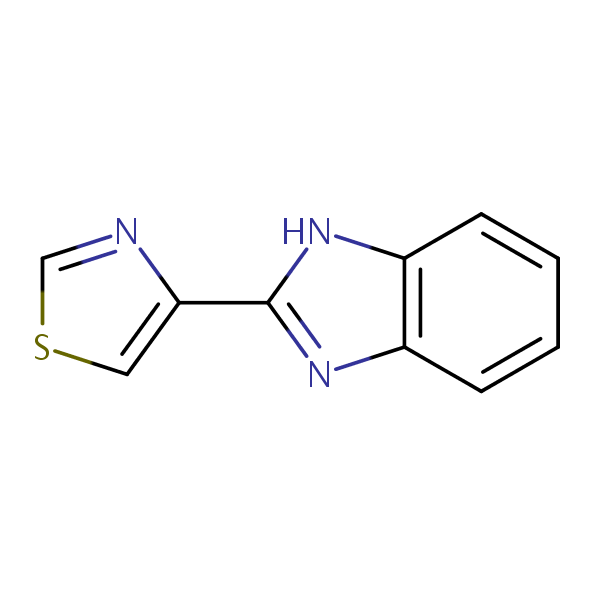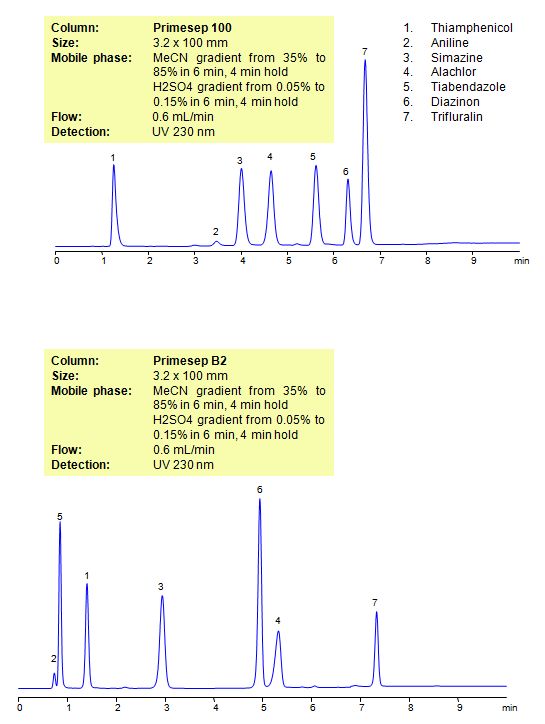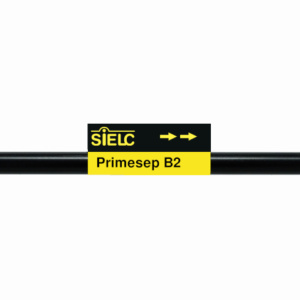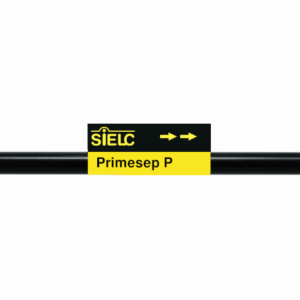| CAS Number | 148-79-8 |
|---|---|
| Molecular Formula | C10H7N3S |
| Molecular Weight | 201.250 |
| InChI Key | WJCNZQLZVWNLKY-UHFFFAOYSA-N |
| LogP | 2.47 |
| Synonyms |
|
Applications:
HPLC Method for Analysis of Thiabendazole on Primesep 100 Column
August 12, 2024
High Performance Liquid Chromatography (HPLC) Method for Analysis of Thiabendazole on Primesep 100 by SIELC Technologies
Separation type: Liquid Chromatography Mixed-mode SIELC Technologies
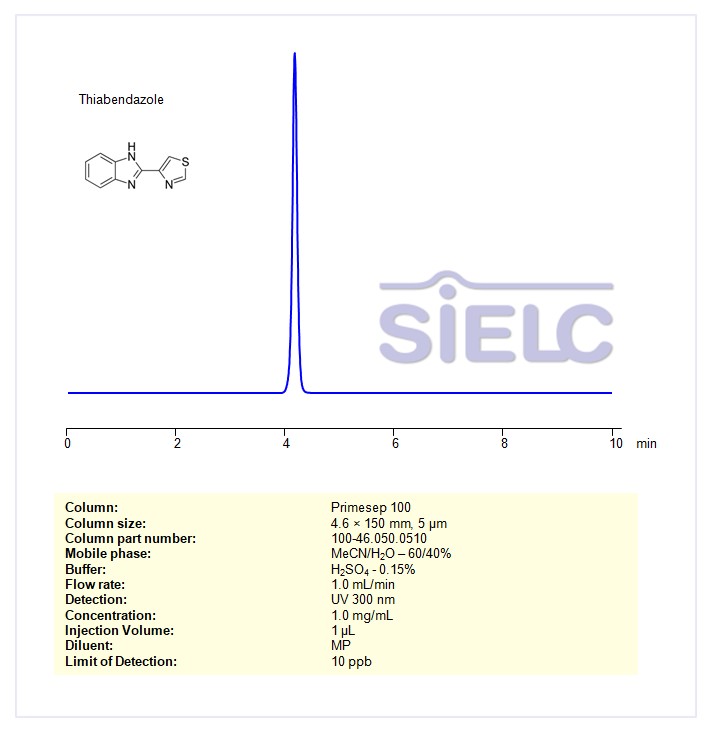
High Performance Liquid Chromatography (HPLC) Method for Analysis of Thiabendazole
Thiabendazole is an anthelmintic and antifungal medication used to treat various parasitic worm infestations and fungal infections. It works by interfering with the energy metabolism of the parasites, effectively killing them. The drug is used in both humans and animals and can be administered orally or topically, depending on the condition being treated.
In humans, thiabendazole is commonly used to treat infections like strongyloidiasis (caused by the parasite Strongyloides stercoralis), trichinosis, and other helminthic infections. It is also sometimes used as a fungicide in agriculture to control mold, rot, and other fungal diseases in crops and fruits.
While effective, thiabendazole can cause side effects such as nausea, dizziness, and abdominal pain. It is typically prescribed when the benefits outweigh the potential risks, and the specific use and dosage depend on the patient’s condition and overall health.
Thiabendazole can be retained, separated and analyzed using a Primesep 100 mixed-mode stationary phase column. The analysis employs a gradient method with a simple mobile phase comprising water, acetonitrile (MeCN), and sulfuric acid as a buffer. This method allows for detection using UV 300 nm.
You can find detailed UV spectra of Thiabendazole and information about its various lambda maxima by visiting the following link.
| Column | Primesep 100, 4.6 x 150 mm, 5 µm, 100 A, dual ended |
| Mobile Phase | MeCN – 60% |
| Buffer | H2SO4 – 0.15% |
| Flow Rate | 1.0 ml/min |
| Detection | UV 300 nm |
| Limit of Detection | 10 ppb |
| Class of Compounds | Herbicide |
| Analyzing Compounds | Thiabendazole |
Application Column
Primesep 100
Column Diameter: 4.6 mm
Column Length: 150 mm
Particle Size: 5 µm
Pore Size: 100 A
Column options: dual ended

HPLC Method for Analysis of Pesticides: Thiamphenicol, Aniline, Simazine, Alachlor, Thiabendazole, Diazinon, Trifluralin on Primesep B2 Column
July 11, 2017
| Column | Primesep B2, 3.2×100 mm, 5 µm, 100A |
| Mobile Phase | Gradient MeCN – 35-85%, 6 min , 4 min hold |
| Buffer | Gradient H2SO4 – 0.05- 0.15%, 6 min, 4 min hold |
| Flow Rate | 0.6 ml/min |
| Detection | UV, 230 nm |
| Class of Compounds |
Drug, Acid, Hydrophilic, Ionizable, Vitamin, Supplements |
| Analyzing Compounds | Thiamphenicol, Aniline, Simazine, Alachlor, Thiabendazole, Diazinon, Trifluralin |
Application Column
Primesep B2
The Primesep family of mixed-mode columns offers a wide variety of stationary phases, boasting unprecedented selectivity in the separation of a broad array of chemical compounds across multiple applications. Corresponding Primesep guard columns, available with all stationary phases, do not require holders. SIELC provides a method development service available to all customers. Inquire about our specially-tailored custom LC-phases for specific separations.
Select optionsAniline
Diazinon
Simazine
Thiabendazole
Thiamphenicol
Trifluralin

Separation of Thiabendazole on Mixed-Mode HPLC Columns
September 9, 2015
Separation type: Liquid Chromatography Mixed-mode
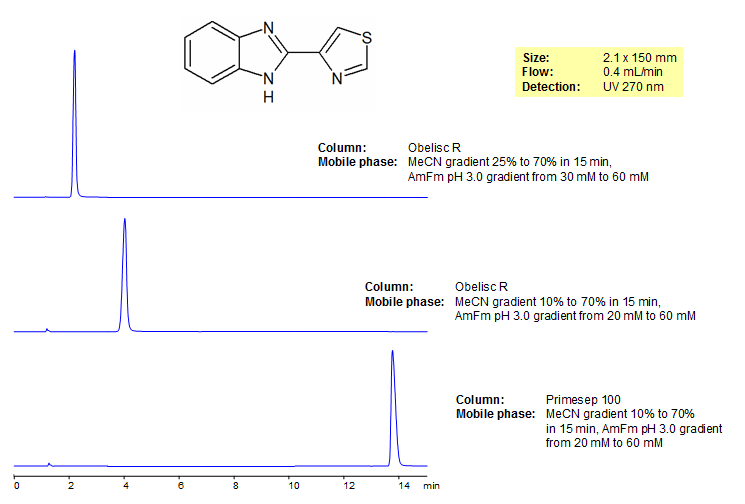
High Performance Liquid Chromatography (HPLC) Method for Analysis of Thiabendazole.
Thiabendazole (TBZ) or tiabendazole is both a fungicide and parasiticide which goes by the trade names Mintezol and Tresaderm. As a fungicide, it controls mold and blight and as a parasiticide it can control various types of worms. According to the EURL-SRM (European Union Reference Laboratory – Single Residue Methods) TBZ is considered difficult to analyze by traditional multiresidue methods. We separated and analyzed TBZ using two mixed-mode columns with different modes of separation. Obelisc R has a long hydrophobic chain and multiple ion-pairing groups, and Primesep 100 contains acidic ion-pairing groups. Method is LC/MS compatible and can be use on many different pesticides.
| Column | Obelisc R, 2.1×150 mm, 5 µm, 100A |
| Mobile Phase | Gradient MeCN – 25-70%, 15 min |
| Buffer | Gradient AmAc pH 3.0- 30-60 mM, 15 min |
| Flow Rate | 0.4 ml/min |
| Detection | UV, 270 nm |
| Column | Obelisc R, 2.1×150 mm, 5 µm, 100A |
| Mobile Phase | Gradient MeCN – 10-70%, 15 min |
| Buffer | Gradient AmAc pH 3.0- 20-60 mM, 15 min |
| Flow Rate | 0.4 ml/min |
| Detection | UV, 270 nm |
| Column | Primesep 100, 2.1×150 mm, 5 µm, 100A |
| Mobile Phase | Gradient MeCN – 10-70%, 15 min |
| Buffer | Gradient AmAc pH 3.0- 20-60 mM, 15 min |
| Flow Rate | 0.4 ml/min |
| Detection | UV, 270 nm |
| Class of Compounds |
Insecticide, Herbicide, Fungicide, Hydrophobic, Ionizable |
| Analyzing Compounds | Thiabendazole |
Application Column
Obelisc R
SIELC has developed the Obelisc™ columns, which are mixed-mode and utilize Liquid Separation Cell technology (LiSC™). These cost-effective columns are the first of their kind to be commercially available and can replace multiple HPLC columns, including reversed-phase (RP), AQ-type reversed-phase, polar-embedded group RP columns, normal-phase, cation-exchange, anion-exchange, ion-exclusion, and HILIC (Hydrophilic Interaction Liquid Chromatography) columns. By controlling just three orthogonal method parameters - buffer concentration, buffer pH, and organic modifier concentration - users can adjust the column properties with pinpoint precision to separate complex mixtures.
Select optionsPrimesep 100
The Primesep family of mixed-mode columns offers a wide variety of stationary phases, boasting unprecedented selectivity in the separation of a broad array of chemical compounds across multiple applications. Corresponding Primesep guard columns, available with all stationary phases, do not require holders. SIELC provides a method development service available to all customers. Inquire about our specially-tailored custom LC-phases for specific separations.
Select options
HPLC Method for Analysis of Pesticides: Thiamphenicol, Aniline, Simazine, Alachlor, Thiabendazole, Diazinon, Trifluralin on Primesep 100 Column
June 11, 2014
| Column | Primesep 100, 3.2×100 mm, 5 µm, 100A |
| Mobile Phase | Gradient MeCN – 35-85%, 6 min , 4 min hold |
| Buffer | Gradient H2SO4 – 0.05- 0.15%, 6 min, 4 min hold |
| Flow Rate | 0.6 ml/min |
| Detection | UV, 230 nm |
| Class of Compounds |
Drug, Acid, Hydrophilic, Ionizable, Vitamin, Supplements |
| Analyzing Compounds | Thiamphenicol, Aniline, Simazine, Alachlor, Thiabendazole, Diazinon, Trifluralin |
Application Column
Primesep 100
Column Diameter: 3.2 mm
Column Length: 100 mm
Particle Size: 5 µm
Pore Size: 100 A
Column options: dual ended
Alachlor
Diazinon
Simazine
Thiabendazole
Thiamphenicol
Trifluralin

HPLC Separation of Bendazoles on Primesep P Column
August 22, 2008
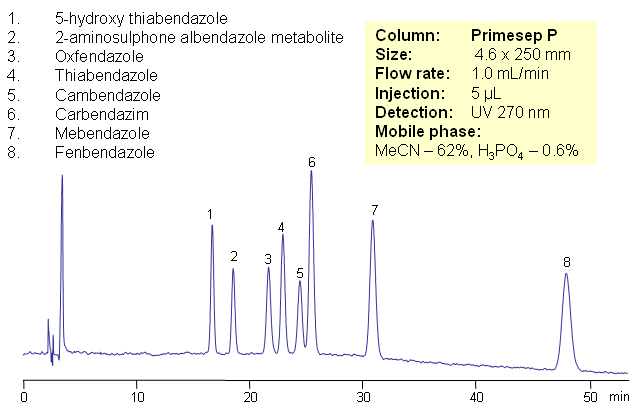
Eight bendazoles are separated on Primesep P HPLC column by combination of reverse phase and ion-exchange mechanisms. Primesep P column can be used when mixed-mode mechanisms, including pi-pi interactions, can benefit separation. HPLC column and method is compatible with UV detection technique.
Application Column
Primesep P
The Primesep family of mixed-mode columns offers a wide variety of stationary phases, boasting unprecedented selectivity in the separation of a broad array of chemical compounds across multiple applications. Corresponding Primesep guard columns, available with all stationary phases, do not require holders. SIELC provides a method development service available to all customers. Inquire about our specially-tailored custom LC-phases for specific separations.
Select options5-Hydroxy Thiabendazole
Albendazole
Cambendazole
Carbendazim
Fenbendazole
Mebendazole
Oxfendazole
Thiabendazole

